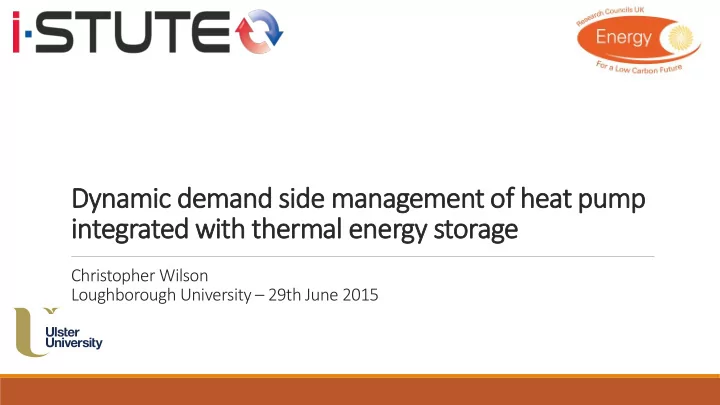

Dynamic demand side management of heat pump integrated with thermal energy storage Christopher Wilson Loughborough University – 29th June 2015
Introduction Project Title Dynamic demand side management of heat pump integrated with thermal energy storage Scope of the project – Aims and Objectives Methodology Analysis Results and Outputs Summary
Project RETROFIT Scope Radiators +60 ° C DSM Minimal Disruption Retrofit – “plug & play” Suitable for existing trade Max 80 ° C flow temp workforce Heat Pump Seasonal COP – min 2.5 to Thermal Storage be renewable – what is the Direct Indirect max achievable? Heat Heat Thermal comfort – gas Electrical for DSM. Heat Demand Cost effective over life cycle.
Other energy storage options… Thermal Storage Latent – PCMs Thermochemical Sensible heat storage Increased storage capacity 600 litre buffer tank DSM Reduced storage volume 14 kWh useful – delta-T 20 (55-75 ° C) Energy loss - 1 ° C/hr Lower heat pump heating coil Upper house central heating coil Cylinder stat Heat Pump Thermal Storage Temperature monitoring De-stratification pump Needs to be high capacity – low energy loss Direct Indirect Compact for domestic situation Heat Heat Meaningful thermal store over 24 hours to realise DSM capabilities Heat Demand
Electric Wind DSM Tariffs Penetration Daily electricity price variation DSM Wind production forecasting… Peak around 15:30 – 19.30 Wind farm dispatch down across Ireland – Managing wind energy variability 2012 Price not lowest at night – Ability to flexibly control DSM tools Instead of turning of wind farms – Turn on some flexibility to balance the grid heat pumps Energy potential utilised Heat Pump Increased wind energy penetration Thermal Storage Direct Indirect Heat Heat Heat Demand
Methodology Retrofit: Bypass existing gas boiler Remains in place as backup Uses existing heating controls 2 scenarios with heat pump: 1. Heat house directly 2. Heat house indirectly via buffer and storage tank
House heated via buffer tank More heat delivered from heat pump than delivered too house Heat pump is on reheat mode – maintains buffer at 75 ° C Daily heat loss of 20 kWh in some cases – 82% efficiency
Benefit of buffer tank High instant power House thermostat quickly satisfied Heat pump running long durations – benefit might not be justified.
Dynamic DSM Controller via Raspberry Pi Raspberry Pi Credit card sized low cost computer - £30 Enables physical computing – ability to control relays + measure sensor inputs (buffer tank temperature) Write python software to control input and output pins Connected to network – retrieves internet data and network control – real time forecast demand Email alerts to phone for malfunction and switches off leaving heat pump in default direct heating mode
Dynamic DSM Controller via Raspberry Pi Normal Operation – Rpi Control – Charging Rpi Control – Using Direct Heat Benefit to store stored heat House call for heat Buffer tank less Benefit to use Relay A normally than 75 ° C Buffer tank > 55 ° C closed RPi Pin 12 closes RPi Pin 11 closes 3PV energises – Relay C energises – Relay A energises – direct heating HP on Heating pump on Relay B energises – HP on
Results & Further Work Initial testing: 1. Raspberry Pi control - dynamic switching between direct and storage mode Only recently installed – further analysis required – tweaking of input parameters Testing using forecast wind electricity production Testing using real time electricity pricing Formulation of optimised demand side management method – Renewable Electricity Tariff Machine learning techniques for true plug and play “ dsm adaptor” Specifications of HP and thermal stores required for efficient DSM
Summary The project goals… Heat pumps to meet the energy demand of domestic house Retrofit system and integration Thermal storage – improve heat pump integration Thermal storage – DSM role Demand side management control COP of HP needs to improve Thermal store needs to increase capacity/reduce in size DSM control needs further optimisation to justify its use and incentivisation
Thanks for your attention. Any Questions?
Recommend
More recommend